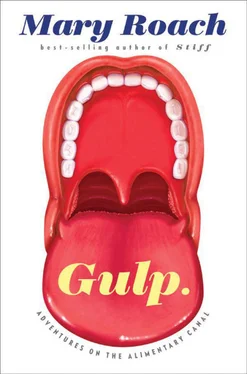Pruetz’s team observed seed reingestion only during the span of weeks when baobab and Fabaceae seeds are too hard to chew. During this time, it takes a second run through the digestive tract to dissolve the hulls and release the proteins and fats in the kernel. Women in the Tanzanian Hadza tribe use a similar technique, harvesting softened baobab seeds from baboon dung, washing and drying them, and pounding them into a kind of flour.
Before you get all high and mighty on the chimps and the Hadza, you should know that the most expensive coffee beans in the world—at upwards of two hundred dollars a pound—are those that have passed through the digestive tract of the civet, a catlike animal native to Indonesia. The animal’s digestive enzymes are said to alter the taste of the beans in a pleasing manner. The trade is lucrative enough to have spawned a market for counterfeit civet dung, crafted from ordinary undigested coffee beans, a dung matrix of similar consistency, and glue.
Though seed reingestion is most prevalent on the savannah, where food is scarcer, it also happens in the rain forest. Pruetz’s paper cites the work of a team of researchers who observed coprophagy in wild mountain gorillas. At a loss to explain the behavior, given the relative bounty of the surroundings, the researchers suggested that it might have been done for the same reason people reach for the Cream of Wheat on a midwinter morning. “They proposed,” Pruetz wrote to me in an e-mail, “that mountain gorillas might like to eat something warm during periods of cold temperatures or heavy rain.”
And now, with all apology, it’s time to move on to Homo sapiens . A 1993 study of “humans behaving in a manner similar to nutrient-deficient animals” involved three institutionalized patients, Bart, Adam and Cora, all with profound developmental disabilities. Charles Bugle and H. B. Rubin successfully broke the trio’s autocoprophagia habits by feeding them a nutritional supplement drink called Vivonex. The authors speculated that this population “often has multiple handicaps and something may be missing that makes it more difficult to digest or metabolize all the nutrients in the diet they are served.” Whether or not this is true, a glass of Vivonex is preferable to some of the alternative strategies tried by staff at other institutions. In particular, that of the team who “treated… coprophagia and feces-smearing by making a shower contingent upon the absence of feces.” You can see where that could go south pretty fast.
THERE IS ONE class of substances that the rectum, even today, is occasionally called on to absorb. Drugs take effect faster this way than by mouth, partly because they bypass the stomach and liver. Opium, alcohol, tobacco, peyote, fermented agave sap, you name it—it’s been taken rectally. In the case of certain South American hallucinogens, rectal indulgence also allows one to sidestep vomiting that accompanies the oral route. Considerably enlivening the pages of Natural History in March 1977, Peter Furst and Michael Coe described the heretofore unrecognized prominence of the “intoxicating enema” in classic Mayan culture. The discovery came about with the examination of a painted Mayan vase from circa 3 A.D. that had previously been hidden away in a private collection. The decorative embellishments feature a man in an elaborate pointy hat but no pants, crouched like a cat, hind quarters raised, while a kneeling consort holds a tubular object to his anus. Another man squats, administering to himself.
Access to the vase brought a thunderclap of realization. “Previously enigmatic scenes and objects in classic Maya art” suddenly made sense. Furst and Coe give the example of a small clay figurine, found in a tomb, of a squatting man reaching back as though to wipe himself. Experts had been puzzled. Why would family members bury a loved one with the Maya equivalent of Manneken Pis? Now it was clear. The man was on a ritual bender. Images on the vase no doubt also helped crack the enigma of what had appeared to be rustic, hand-hewn turkey basters—hollow bones with animal or fish bladders attached at one end—turning up at archaeological digs all over South and Central America. “South American Indians,” observe Furst and Coe, “were the first people known to use native rubber-tree sap for bulbed enema syringes.”
Is it not possible that the images on the vase depict a simple laxative procedure? Furst and Coe address this, insisting that only partakers of the “Old World enema” were concerned with constipation. (Sometimes to excess. The authors note that Louis XIV had more than two thousand clysters during his reign, sometimes “receiving court functionaries and foreign dignitaries during the procedure.” The Louis passion for the syringe can be traced through the lineage as far back as XI, who had enemas administered to his dogs.)
The southern route has advantages as well for administering poisons. Bypassing the taste buds—and the court taster, if such an entity actually existed—allowed murderers to get away with a higher dose. Some historians believe the Roman emperor Claudius was killed in this manner, at the behest of his fourth wife, the fetching and far younger Agrippina. Ostensibly the motive was political. Agrippina was in a rush to install her son from a previous marriage as Rome’s emperor. There was also this, courtesy of Suetonius: “His laughter was unseemly and his anger still more disgusting, for he would foam at the mouth and trickle at the nose; he stammered besides and his head was very shaky.” And this, from the September 5, 1942, issue of the Journal of the American Medical Association : “The emperor Claudius… suffered from flatulence.” [109] Which explains the otherwise curious legislative decision to pass an edict that “no Roman need feel reticent about passing flatus in public.”
By far the oddest reverse delivery on record is the holy-water enema. The first reference I came upon, a passing mention in an art journal, suggested that the holy-water clyster was a routine weapon in the exorcist’s arsenal. This made a certain amount of sense: Why sprinkle the possessed with holy water when you can pump it right up inside them? Seeking to verify the practice, I e-mailed the public relations office of the United States Conference of Catholic Bishops, the stateside headquarters of the Catholic Church. Naturally this went unheeded. Returning to the art journal, I consulted the article’s references, ordered a copy of the cited paper, and hired a translator, as it had been published in an Italian medical journal.
The holy-water enema, by this account, was an isolated case, involving Jeanne des Anges, the mother superior of an Ursuline convent in Loudun, France, in the early 1600s. Des Anges claimed that the parish priest, a raffish, high-ranking charmer named Urbain Grandier, was appearing to her in her dreams, caressing her and attempting to seduce her. He seemed to be having some measure of success, as the contemplative quiet of the convent was being shattered by the mother superior’s nightly shrieks of sexual frenzy. An exorcism was promptly ordered.
Why would one administer the blessed liquid rectally instead of simply having the possessed drink a glass of it? One explanation is that the original Roman Catholic rite for the Blessing of the Holy Water included adding salt to the water. Regardless of the origins of the practice, this had the effect of rendering it undrinkable. [110] Is drinking holy water allowed? Clear-cut answers are elusive. One priest I contacted pointed out that holy water is baptismal water, meant for blessing and dunking, not drinking. Another, however, directed me to the website of McKay Church Goods, which sells five different models of “Holy Water tanks.” These are six-gallon freestanding dispensers with push-button spigots, along the lines of the office water cooler but with a cross on top. There are definitely parishioners who drink it, and priests who wish they wouldn’t. St. Mary’s Parish in Cutler, California, has had both. In 1995, Father Anthony Sancho-Boyles, to discourage tippling, resorted to the old practice of adding salt to the holy water. The following Sunday a woman complained, saying that she used the holy water to make coffee in the mornings, and now her coffee tasted funny.
Читать дальше












